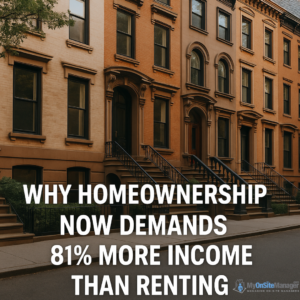For decades, owning a home was seen as a natural next step in building wealth and stability something to aspire to after years of renting. But in 2025, the dream of homeownership is becoming more elusive than ever. New data reveals a stark reality: you now need to earn 81% more income to buy a home than to rent one.
The Stark Income Divide
According to Pro Builder’s analysis of Redfin data, the annual income required to comfortably purchase a median-priced home in the U.S. has climbed to $116,633. In contrast, renting a typical apartment requires just $64,160 per year. That’s a gap of over $52,000 and it’s widening fast.
Just a year ago, buyers needed about 73% more income than renters. This year’s jump to 81% underscores how quickly the affordability crisis is accelerating.
Why the Gap is Growing
Two forces are driving this widening chasm between owning and renting:
1. Soaring Home Prices
The median price of a U.S. home has risen 4.5% year-over-year, reaching approximately $423,892 as of February 2025.
A big reason for this is limited housing inventory. Many current homeowners are “locked in” with ultra-low mortgage rates from previous years and are unwilling to sell, tightening supply and pushing prices higher.
2. Slowing Rent Growth
While home prices climb, rent growth has all but stalled. Median asking rents rose by just 0.2% year-over-year, hovering around $1,604 per month.
This moderation is partly due to a surge in new apartment construction that began during the pandemic, which is now hitting the market and easing rental demand pressures.
Mortgage Rates: The Silent Weight
It’s not just home prices making ownership harder mortgage rates remain stubbornly high. Even if a home’s asking price hasn’t skyrocketed, elevated interest rates significantly increase monthly payments, making it harder for buyers to qualify under lending requirements.
For example, a 1% increase in mortgage rates can add hundreds of dollars to a monthly payment, which means needing thousands more in annual income just to stay within the typical 30% income-to-housing-cost ratio.
What This Means for Renters
For many, the math simply doesn’t add up. Even financially stable renters may find themselves “priced out” of ownership not because they can’t handle a monthly mortgage, but because they can’t meet the income thresholds lenders require.
This delay in entering the housing market can have long-term effects on wealth-building, retirement planning, and financial security.
The Policy & Market Response
The growing income gap is a call to action for both policymakers and the housing industry:
-
Increase Housing Supply: Encourage development of affordable starter homes, not just luxury builds.
-
Expand Financing Options: Explore flexible mortgage programs that responsibly widen access to first-time buyers.
-
Support Zoning Reform: Allow for more diverse housing types, such as duplexes, townhomes, and accessory dwelling units (ADUs).
-
Innovate in Construction: Use cost-efficient building methods like modular housing and 3D-printed homes to reduce overall costs.
The Bottom Line
The American dream of homeownership is still alive but it’s facing one of its biggest challenges in decades. With the income gap between renting and buying now at 81% and likely to grow prospective buyers must navigate a market that demands more savings, higher earnings, and creative strategies to secure a place to call their own.
Source: Homebuyers Now Need to Earn 81% More Than Renters – Pro Builder

